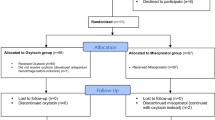Abstract
Purpose
To systematically review the literature about maternal and neonatal outcomes following induction of labor (IOL) and spontaneous labor (SL) in women with previous cesarean section (PCS).
Methods
PubMed, Medline, EMBASE, Cochrane library searches; January 2000–February 2013. Inclusion criteria: women attempting labor after PCS, singleton term pregnancies. Women undergoing IOL were compared with women in SL. Method for induction, mode of delivery, uterine rupture/dehiscence, post-partum hemorrhage, emergency hysterectomy and any maternal or neonatal morbidity and mortality were analyzed. MOOSE guidelines were followed. Interstudies heterogeneity was tested. A random effect model was generated if heterogeneity was >25 %. Pooled odds ratio with 95 % confidence interval (OR, 95 % CI) were calculated.
Results
Eight articles included 4,038 women with IOL (23.2 %) and 13,374 women with SL (76.8 %). IOL was associated with a lower incidence of vaginal delivery (OR 0.66; 95 % CI 0.55–0.80) and higher rates of cesarean section (OR 1.52; 95 % CI 1.26–1.83), uterine rupture/dehiscence (OR 1.62; 95 % CI 1.13–2.31), and post-partum hemorrhage (OR 1.57; 95 % CI 1.20–2.04), although hysterectomy was similar between the two groups (OR 2.60; 95 % CI 0.52–13.1). Neonatal morbidity was similar after IOL or SL (OR 1.13; 95 % CI 0.75–1.69).
Conclusions
Induction of labor increases the risk of uterine rupture/dehiscence and of repeat cesarean section.







Similar content being viewed by others
References
MacKenzie IZ, Bradley S, Embrey MP (1984) Vaginal prostaglandins and labour induction for patients previously delivered by caesarean section. Br J Obstet Gynaecol 91:7–10
Vause S, Macintosh M (1999) Evidence based case report: use of prostaglandins to induce labour in women with a caesarean section scar. BMJ 318:1056–1058
Lydon-Rochelle M, Holt VL, Easterling TR, Martin DP (2001) Risk of uterine rupture during labor among women with a prior cesarean delivery. N Engl J Med 345:3–8
Locatelli A, Regalia AL, Ghidini A, Ciriello E, Biffi A, Pezzullo JC (2004) Risks of induction of labour in women with a uterine scar from previous low transverse caesarean section. BJOG 111:1394–1399
Kayani SI, Alfirevic Z (2005) Uterine rupture after induction of labour in women with previous caesarean section. BJOG 112:451–455
Jozwiak M, Dodd JM (2013) Methods of term labour induction for women with a previous caesarean section. Cochrane Database Syst Rev 3:CD009792
Udayasankar V, Padmagirison R, Majoko F (2008) National survey of obstetricians in Wales regarding induction of labour in women with a previous caesarean section. J Obstet Gynaecol 28:48–50
Gupta P, Elmardi A, Bathula U, Chandru S, Charlesworth D (2011) Induction of labour in women with one previous caesarean section. J Obstet Gynaecol 31:131–133
Alsayegh AK, Roshdy S, Hany Akef A, Maha Youssef S (2007) Induction of labor with prostaglandin e2 in women with previous cesarean section and unfavorable cervix. Int J Health Sci (Qassim) 1:211–216
Delaney T, Young DC (2003) Spontaneous versus induced labor after a previous cesarean delivery. Obstet Gynecol 102:39–44
Lin C, Raynor BD (2004) Risk of uterine rupture in labor induction of patients with prior cesarean section: an inner city hospital experience. Am J Obstet Gynecol 190:1476–1478
Ravasia DJ, Wood SL, Pollard JK (2000) Uterine rupture during induced trial of labor among women with previous cesarean delivery. Am J Obstet Gynecol 183:1176–1179
Umeadi UP, Mehta R, Thomas S (2007) Delivery outcome after induction of labour using prostaglandin in women with one previous caesarean section. J Obstet Gynaecol 27:810–811
Yogev Y, Ben-Haroush A, Lahav E, Horowitz E, Hod M, Kaplan B (2004) Induction of labor with prostaglandin E2 in women with previous cesarean section and unfavorable cervix. Eur J Obstet Gynecol Reprod Biol 116:173–176
Shatz L, Novack L, Mazor M, Weisel RB, Dukler D, Rafaeli-Yehudai T, Israeli O, Erez O (2013) Induction of labor after a prior cesarean delivery: lessons from a population-based study. J Perinat Med 41:171–179
Agnew G, Turner MJ (2009) Vaginal prostaglandin gel to induce labour in women with one previous caesarean section. J Obstet Gynaecol 29:209–211
Chilaka VN, Cole MY, Habayeb OM, Konje JC (2004) Risk of uterine rupture following induction of labour in women with a previous caesarean section in a large UK teaching hospital. J Obstet Gynaecol 24:264–265
Gomez LR, Burgos J, Cobos P, Melchor JC, Osuna C, Centeno Mdel M, Larrieta R, Fernandez-Llebrez L, Martinez-Astorquiza T (2011) Oxytocin versus dinoprostone vaginal insert for induction of labor after previous cesarean section: a retrospective comparative study. J Perinat Med 39:397–402
McDonagh MS, Osterweil P, Guise JM (2005) The benefits and risks of inducing labour in patients with prior caesarean delivery: a systematic review. BJOG 112:1007–1015
Conflict of interest
We declare that we have no conflict of interest.
Author information
Authors and Affiliations
Corresponding author
Rights and permissions
About this article
Cite this article
Rossi, A.C., Prefumo, F. Pregnancy outcomes of induced labor in women with previous cesarean section: a systematic review and meta-analysis. Arch Gynecol Obstet 291, 273–280 (2015). https://doi.org/10.1007/s00404-014-3444-9
Received:
Accepted:
Published:
Issue Date:
DOI: https://doi.org/10.1007/s00404-014-3444-9




